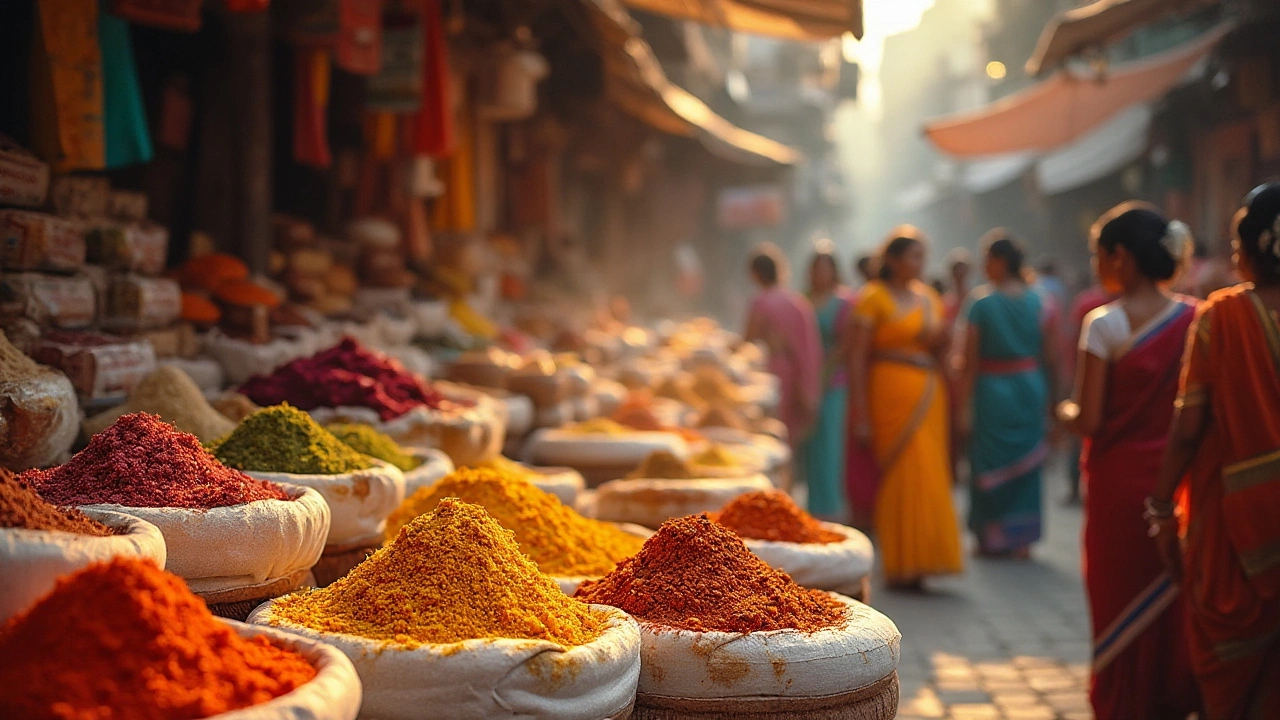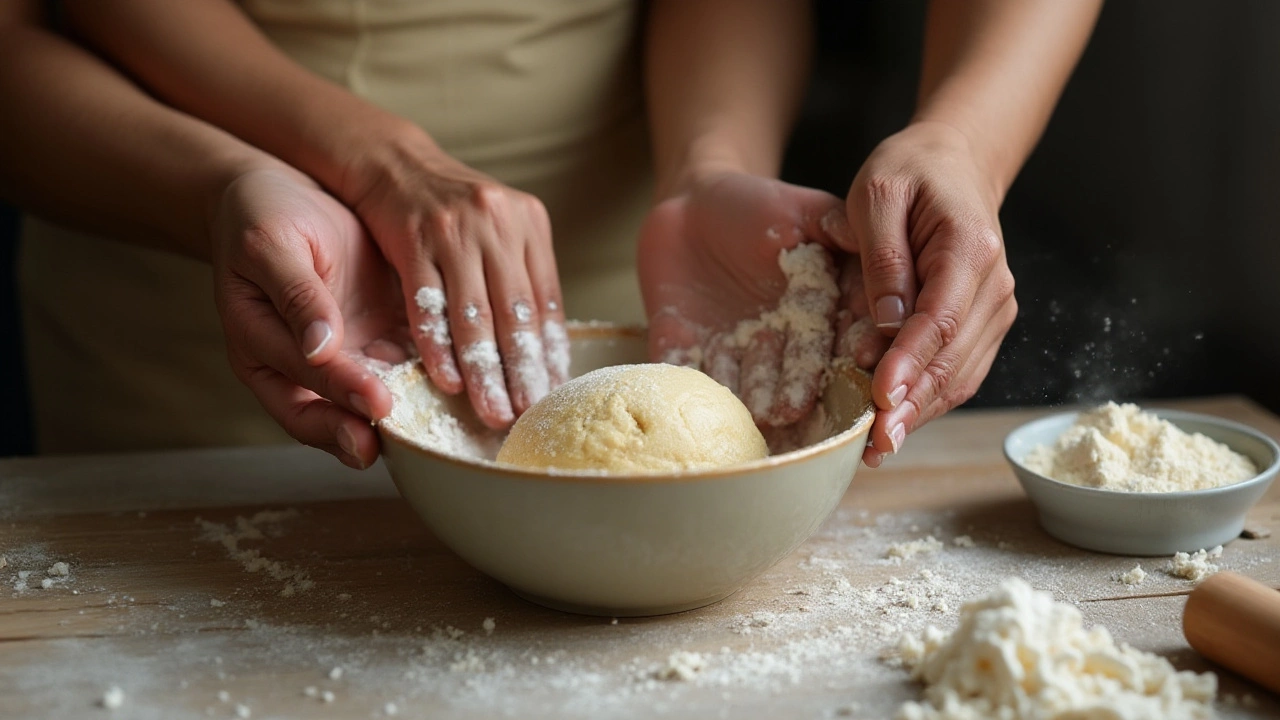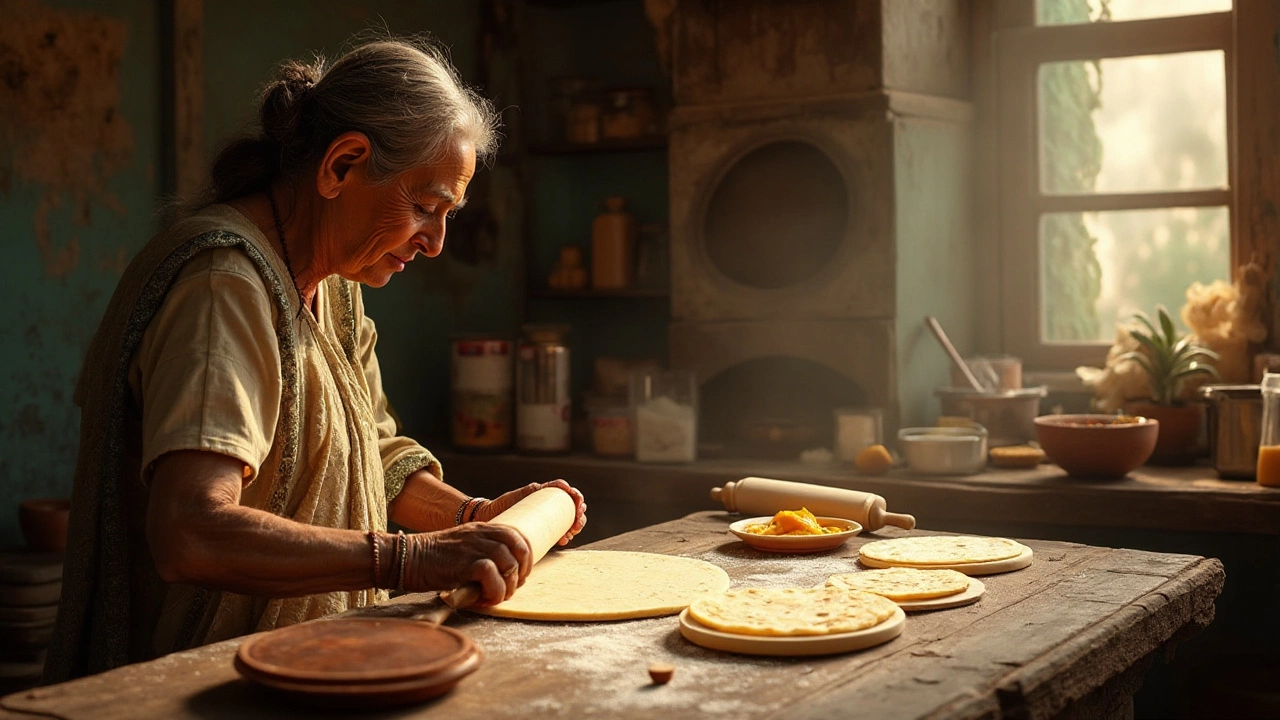Roti, a staple in many households, is much more than just a simple flatbread. It's a canvas that carries the essential flavors of a meal while holding a cultural significance that runs deep within many communities. But does it need baking powder to achieve its characteristic softness and puffiness? The answer is more nuanced than a simple yes or no.
Traditionally, roti is made using flour, water, and sometimes a little oil, kneaded into a soft dough that's rolled out and cooked on a hot griddle. This method relies on the skill and technique of the cook to create a beautifully soft bread. However, modern variations often introduce baking powder, an ingredient more familiar in Western baking, to lend an airiness that some might find lacking.
- The Traditional Way of Making Roti
- The Chemistry Behind Baking Powder
- Impact of Baking Powder on Roti Texture
- Alternatives to Baking Powder
- Expert Tips for Perfect Roti Every Time
The Traditional Way of Making Roti
Making roti—a quintessential element of Indian and South Asian cuisine—is a cherished ritual passed down through generations. Traditionally, this humble yet revered flatbread requires only a handful of ingredients: flour, water, and a pinch of salt. The magic begins with selecting the flour—called 'atta,' a type of whole wheat flour that's finely milled. This is essential as it provides the right texture and pliability, crucial for the perfect roti.
The process starts with mixing the atta with water until it forms a coherent dough. This isn't a hurried task; rather, it's an exercise in patience and technique. As you knead the dough using your palms, it should feel soft and supple, much like a warm embrace that gives under pressure but doesn't tear. The mixing and kneading allow the gluten in the flour to develop, giving the roti its chewy structure and the ability to puff up when cooked.
Once the dough is smooth and elastic, it's divided into small balls, each the size of a walnut. These are then rolled out flat using a rolling pin, an art in itself, where skill determines whether your roti will be irregularly shaped or a perfect circle. The secret to perfect rolling, as many grandmothers would advise, is to apply even pressure and keep the dough constantly moving in a circular motion.
Cooking the roti involves a hot tawa, a round iron griddle that acts as a stage for this culinary dance. The rolled-out dough is gently laid on a pre-heated tawa, allowing it to cook until faint bubbles appear. At that moment, it's flipped to cook on the other side. A second flip is often done to encourage the formation of those delightful air pockets that characterize a perfectly cooked roti.
"Cooking a good roti is not just about measuring ingredients but feeling the dough's texture in your hands and learning how it responds to heat," says renowned chef Madhur Jaffrey, highlighting the sensory knowledge that comes with experience.
The entire process of making roti traditionally is much more than feeding the body; it's about connecting with one’s roots and preserving a cultural heritage. Each step is imbued with love, patience, and a desire to nourish both body and soul. As you savor each bite, you're not just eating food but also imbibing the essence of an age-old tradition.
The Chemistry Behind Baking Powder
Baking powder is a fascinating ingredient, a modern marvel often tucked away discreetly in kitchen cupboards yet playing a pivotal role in crafting the perfect baked goods. It consists of a mixture of a base, typically sodium bicarbonate, and a weak acid, such as cream of tartar or sodium aluminum sulfate. This combination is crafted to create a delightful chemistry magic show in the comfort of your kitchen. Bakers rely on this leavening agent to produce carbon dioxide gas when mixed with moisture and heat, contributing to the rise and fluffiness that defines much of our baked repertoire.
The role of baking powder in cooking, especially in the making of roti, often stirs debate among culinary enthusiasts. Though originally omitted in traditional roti recipes, its inclusion in modern adaptations can profoundly influence the bread's texture. The leavening effect of baking powder is akin to filling a balloon slowly, where the gas expansion gently raises the dough, creating a light and airy texture. This transformation is a blend of culinary art and scientific precision, which can seem like conducting a symphony in the warm confines of an oven or stovetop.
Let's delve deeper into the chemical process. When the baking powder is activated, its acidic and alkaline components react, leading to the formation of small bubbles of gas trapped within the dough. These bubbles expand with heat, contributing to the desired fluffiness and soft texture. This process is crucial in baked goods where a delicate crumb is a craved feature. Although fascinating, the trick lies in the precision of measurements and understanding exact proportions, as too much can disrupt the flavor and texture balance.
As food science expert Harold McGee writes in his renowned book
"On Food and Cooking," baking powder does not offer unlimited power to raise but works most effectively when the dough's ratio and handling are spot on, stressing on its balanced integration is key."Modern adaptations of roti, where innovation meets tradition, often embrace this ingredient to enhance texture, although purists may argue it detours from authenticity. It's a beautiful tug-of-war between embracing tradition and welcoming change, each with its intriguing reasons.
Attempting to bring science into art, bakers wield baking powder as an effective tool to compensate for manual skills one might not possess. It narrows the gaps brought by room temperature, flour type, and sometimes the tenderness of the cook's touch. Yet, relying purely on baking powder rewires the entire cooking process, prompting questions about authenticity and cultural integrity. Thus, the journey of using it in roti making evolves with time, offering cooks a wider palette for improvisation without losing sight of culinary genuineness.

Impact of Baking Powder on Roti Texture
Baking powder is a leavening agent that has gained popularity in the world of roti making due to its ability to create a lighter, fluffier texture. But what exactly happens when this ingredient is added to your dough? As a chemical leavening agent, baking powder releases carbon dioxide when mixed with moisture and heated. This gas forms tiny bubbles within the dough, causing it to rise and expand. The result is a roti that feels softer to the touch and gives a more pillow-like mouthfeel compared to its traditional counterpart. However, it's crucial to understand that the use of baking powder can also alter the subtle flavor profile of Indian bread, which can be a desirable quality for some, but others may prefer the authentic taste unaltered.
One might wonder if there’s an ideal amount of baking powder to use. Too little and you might not notice the difference, but excess can lead to an undesirable alkaline taste and a coarse texture. Typically, adding about a teaspoon of baking powder per two cups of flour is a safe starting point, allowing you to experiment within this framework to find your preferred balance of softness and flavor. The process of experimenting itself can be quite fascinating, as it unveils how each slight variation can dramatically alter the end product.
For those new to this practice, it’s interesting to note that baking powder compositions might vary by brand. Some contain more sodium or different acid types that affect the effervescence and expansion process in unique ways. The versatility of this ingredient can be both a boon and a complexity, especially when exploring various types of flours beyond all-purpose, like whole wheat or millet, which traditionally do not pair with leavening agents. A cooking expert once remarked,
"Incorporating baking powder into roti-making is like opening a door to endless possibilities where tradition meets modern inventiveness."This integration can be seen as a bridge between culinary history and innovation, captivating anyone eager to deepen their intimate connection with food.
Alternatives to Baking Powder
When crafting the perfect roti, the quest for softness and fluff may deter traditionalists from adding baking powder, steering them instead towards natural avenues. For those seeking alternatives to leavening agents, several viable options can render the same delightful results without compromising on taste or tradition. One time-tested substitute is yogurt, a common ingredient in many Indian households, known for its mild acidity and natural yeast properties. By mixing yogurt into the dough, you invite a gentle fermentation process to occur, yielding a tender bread with an unmistakable tang that complements the simplicity of roti perfectly.
Another alternative is baking soda, used sparingly, which can mimic the effects of baking powder when combined with an acidic element like lemon juice or vinegar. This combination creates the same chemical reaction achievable with commercial leavening agents. Yet, what truly makes this approach appealing is its reliance on everyday kitchen staples, making it an accessible and sustainable choice for most home cooks. Historically, women have passed down roti-making secrets without a hint of leavening agents, relying instead on deft hands and a practiced touch. However, adapting to modern ingredients provides a bridge between tradition and innovation.
In conversation with renowned chef Anita Sharma, known for her expertise in Indian culinary traditions, it was revealed that, "The magic of Indian bread lies not in the additions, but in the practice. With a well-kneaded dough and a perfectly heated tawa, even the simplest roti can become a culinary masterpiece." Such insights highlight the importance of technique over ingredients, suggesting that perhaps, a hands-on approach is the most authentic alternative to reliance on baking powder.
For those exploring gluten-free versions, alternative flours like chickpea or millet may offer fresh textures and flavors. Although these require different handling and liquid ratios, they introduce variety and nutritional benefits without losing the essence of roti making. Experimentation, after all, is the spice of life, and in cooking, it opens new paths for diversity on the plate.

Expert Tips for Perfect Roti Every Time
Achieving the perfect roti is as much about practice as it is about knowing the right tips and tricks. It's an art – one that involves listening to the sound of sizzling dough on a hot pan and feeling the texture of the dough between your fingers. The journey to the perfect roti can be a rewarding one, where every little tweak in technique can make a world of difference. Let's delve into some time-tested tips from seasoned cooks who know the intricacies of roti making intimately.
Firstly, the choice of flour is crucial. Opt for whole wheat flour, preferably freshly milled, as it contains the right balance of proteins and carbohydrates that give roti its unique texture. A good flour blend can make your flatbreads soft and flavorful. Use warm water to create the dough, which helps in activating the gluten, making your dough pliable and easy to roll.
Kneading the dough perfectly is perhaps one of the most important steps in making a great roti. It should be kneaded until it is smooth and elastic, which might take a good ten minutes. Patience in kneading pays off as it ensures that your roti will puff up nicely on the griddle. After kneading, let your dough rest for at least 20 minutes. This resting period allows it to relax, making it easier to roll out without cracking or shrinking.
"A well-rested dough is like a calm mind; it's resilient and gives its best performance," wisely advises Radha Mittal, a culinary expert known for her traditional cooking classes.
When it comes to rolling, consistency and even thickness are paramount. Keep the edges slightly thinner than the center, and avoid flouring your surface too much, as this can dry out the roti. Use a light hand and roll gently, ensuring the dough doesn’t stick to the rolling pin or surface.
Cooking your roti requires the right temperature, as a low heat will harden the bread and too high will cause it to burn. The griddle should be hot enough so that when you place the roti on it, small air bubbles form almost immediately. Flip it when tiny brown spots start to appear, then press gently with a cloth or spatula to encourage it to puff. The puffiness indicates that the steam inside is cooking not only the exterior but also pushing upwards to create a soft interior texture.
Additional Flavor Enhancements
If you're looking to add a touch more flavor or texture to your roti, consider these additional tips. Mix a tablespoon of ghee or butter into the dough for a richer taste. Adding a smidgen of yogurt can also boost softness. Some home cooks sprinkle a bit of fenugreek or carom seeds into the dough for an aromatic twist that pairs beautifully with curries and lentils.
Finally, remember that practice is key to mastering roti making. Don't be discouraged if your first few attempts aren't perfect. With time, the feel of perfectly kneaded dough and the sight of a beautifully puffed roti will become second nature, transforming your culinary repertoire into something truly exceptional.
